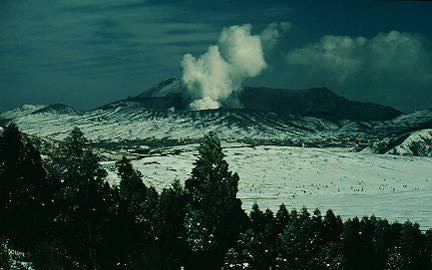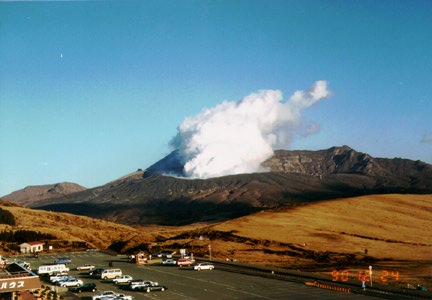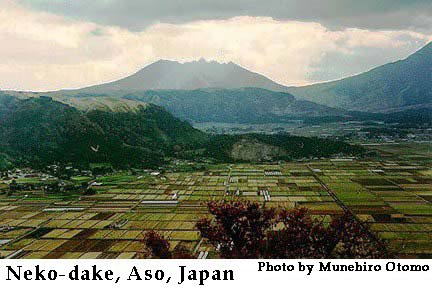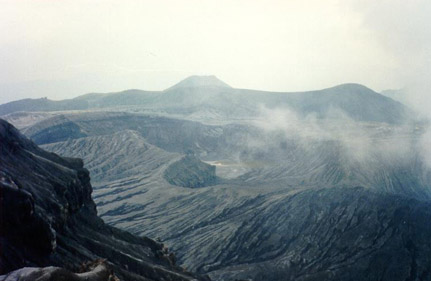Aso (original) (raw)

Aso volcano has produced more explosive eruptions than any other volcano in the world.
Aso is a caldera about 12 miles (20 km) in diameter. Of the numerous stratovolcanoes and cinder cones inside the caldera only Naka-dake has been active in historic time. The first documented eruption in Japan was at Naka-dake in 553. Since then, Naka-dake (shown above) has erupted 167 times. The most recent eruption ended in 1993. Most eruptions of Naka-dake are small to moderate in size. Most are simple explosions that produce ash or blocks. Aso has not produced lava flows in historic time. Only 8 eruptions have caused fatalities. Most fatalities are tourists on the rim of the cone. Note people sledding and skiing in the foreground. Photograph courtesy of and copyrighted by Paul J. Buklarewicz.

Looking across Aso caldera. One of the numerous cones inside the caldera is in the foreground. Photograph courtesy of and copyrighted by Paul J. Buklarewicz.

Aso viewed from the visitors center. Small plume above Aso during a period of mild Strombolian eruptions, December 30, 1991. Photograph by Mike Lyvers.

Space Shuttle Photo of Aso caldera.

Aso's caldera wall.
 |
The central complex of active and inactive volcanoes in the middle of the caldera from the same viewpoint as above. |
|---|

Naka-dake, the active crater, blowing a smoke ring.

The inactive craters at Naka-dake with people standing on the rim of the active crater (out of sight to the left) for scale.

A sulfurous lake in one of the inactive craters.
  |
|---|
| A panorama of Naka-dake's active (left) and inactive craters (right), summer 1990. |
 |
Some of the concrete bomb shelters placed near the edge of Naka-dake's active crater for tourists to shelter in if there is a shower of bombs. |
|---|

The crater edge and steam column.
 |
A view looking down inside Naka-dake's active crater. By day, steam obscures the view but minor fireworks were visible at night - winter 1991. |
|---|
 |
Dr. Kikuchi of the Aso Volcanological Laboratory and his system of underground lasers which he uses to measure the degree of inflation of the volcano. |
|---|

The bomb shelters buried in recent ashfall prior to the summer of 1992.
 |
The crater with a lake formed during the rainy season of 1992. There were occasional small geyser-like eruptions from this lake. |
|---|


The beautiful Takachiho Gorge near Mt. Aso, with its columnar basalt.
VolcanoWorld wishes to thank Mike Lyvers for generously sharing his photographs.
Sources of Information:
Kuno, H., 1962, Part XI, Japan, Taiwan and Marianas: Catalogue of the active volcanoes of the world including solfatara fields, International Association of Volcanology, Rome, Italy, 332 p.
McClelland, L., Simkin, T., Summers, M., Nielsen, E., and Stein, T.C., 1989, Global Volcanism 1975-1985: Englewood Cliffs, New Jersey, Prentice Hall, 655 p.
Simkin, T., and Siebert, L., 1994, Volcanoes of the World: Geoscience Press, Tucson, Arizona, 349 p.